
A Lutheran chorale is a musical setting of a Lutheran hymn, intended to be sung by a congregation in a German Protestant Church service. The typical four-part setting of a chorale, in which the sopranos sing the melody along with three lower voices, is known as a chorale harmonization.

Johann Adam Hiller was a German composer, conductor and writer on music, regarded as the creator of the Singspiel, an early form of German opera. In many of these operas he collaborated with the poet Christian Felix Weiße.
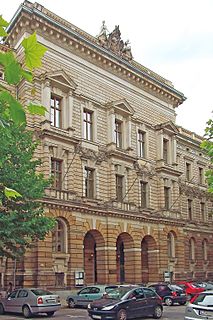
The University of Music and Theatre "Felix Mendelssohn Bartholdy" Leipzig is a public university in Leipzig. Founded in 1843 by Felix Mendelssohn as the Conservatorium der Musik , it is the oldest university school of music in Germany.
Johann Eberlin von Günzburg was a German theologian and reformer who became prominent as the author of reformist flysheets and pamphlets.
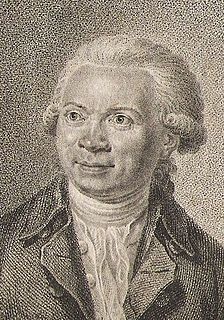
Johann Abraham Peter Schulz was a German musician. He is best known as the composer of the melody for Matthias Claudius's poem "Der Mond ist aufgegangen" and the Christmas carol "Ihr Kinderlein kommet".

The Thomanerchor is a boys' choir in Leipzig, Germany. The choir was founded in 1212. At present, the choir consists of about 90 boys from 9 to 18 years of age. The members, called Thomaner, live in a boarding school, the Thomasalumnat, and attend the Thomasschule zu Leipzig, a Gymnasium school with a linguistic profile and a focus on musical education. The younger members attend the primary school 76. Grundschule in der Manetstraße. Johann Sebastian Bach served as Thomaskantor, director of the choir and church music in Leipzig, from 1723 to 1750.
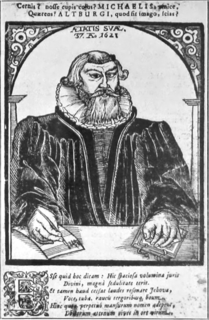
Michael Altenburg was a German theologian and composer.
Johann Gottfried Schnabel was a German writer best known for his novel Insel Felsenburg. He published his works under the pen name Gisander.
Johannes Christoph Andreas Zahn was a German theologian and musicologist best known for his opus Die Melodien der deutschen evangelischen Kirchenlieder, a critical anthology of almost 9000 hymn melodies developed and used in German Lutheran churches.
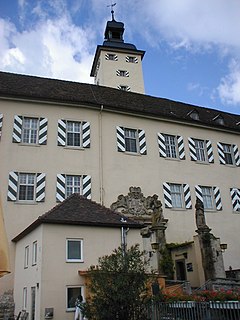
The Transylvanian Museum is a museum situated in Gundelsheim, Germany, dedicated to the protection, preservation and documentation of the cultural heritage of the Transylvanian Saxons and of their coexistence with the other Transylvanian ethnic groups in this multi-ethnic region.
Johann Hugo von Wilderer was a German Baroque composer. He was born in Bavaria and died in Mannheim, where in his later years he served as the Kapellmeister of the court orchestra. His compositions include eleven operas, two oratorios, cantatas, and sacred works.
Walter Blume was a German kapellmeister, music critic, and scholar of Johannes Brahms.
Johann Ulich, the younger was a German organist and composer in Zerbst, and music teacher to the princely family.
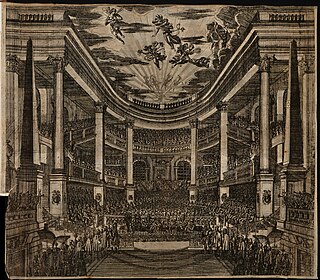
The Opernhaus am Taschenberg was a theatre in Dresden, Saxony, Germany, built from 1664 to 1667 by Wolf Caspar von Klengel. It was the first opera house of the capital of Saxony, Residenz of the Elector of Saxony. Seating up to 2000 people, it was at the time one of the largest opera houses in Europe. It was also called Klengelsches Opernhaus and Komödienhaus am Taschenberg.
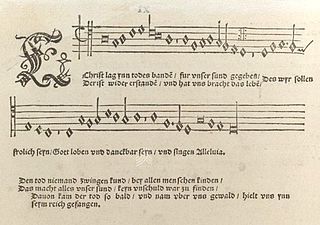
Eyn geystlich Gesangk Buchleyn, sometimes called First Wittenberg Hymnal and Chorgesangbuch, was the first German hymnal for choir, published in Wittenberg in 1524 by Johann Walter who collaborated with Martin Luther. It contains 32 sacred songs, including 24 by Luther, in settings by Walter for three to five parts with the melody in the tenor. Luther wrote a preface for the part books. The collection has been called the root of all Protestant song music.
Zipser German is a Germanic dialect which developed in the Upper Zips region of what is now Slovakia among people who settled there from central Germany beginning in the 13th century. The Lower Zips was inhabited by other Central Germans who spoke a similar dialect called "Gründlerisch" which is considered to be the same language. Beginning in at least the 18th century, many Zipsers migrated to northern Romania, including to southern Bukovina, where several other Germanic dialects were also spoken. Over time, the speech of the Zipsers in Romania was heavily influenced by that of people from Upper Austria who settled among them and were ultimately assimilated into the Zipser ethnic community. During and after the Second World War, most Zipsers evacuated or were expelled to Germany, but a community of speakers remains in Hopgarten; their distinctive dialect is called "Outzäpsersch".

Martin Luther was a great enthusiast for music, and this is why it forms a large part of Lutheran services; in particular, Luther admired the composers Josquin des Prez and Ludwig Senfl and wanted singing in the church to move away from the ars perfecta and towards singing as a Gemeinschaft (community). Lutheran hymns are sometimes known as chorales. Lutheran hymnody is well known for its doctrinal, didactic, and musical richness. Most Lutheran churches are active musically with choirs, handbell choirs, children's choirs, and occasionally change ringing groups that ring bells in a bell tower. Johann Sebastian Bach, a devout Lutheran, composed music for the Lutheran church: more than half of his over 1000 compositions are or contain Lutheran hymns.
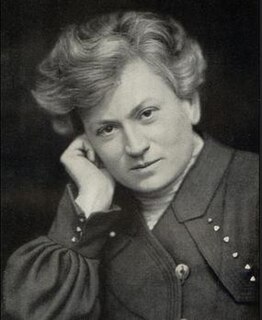
Ika Freudenberg was a leading protagonist of the women's movement in Bavaria.
TAKT is a group of writers and composers of new songs for tuse in Christian churches, initiated in 1947. The genre which the members promoted was later called Neues Geistliches Lied. The name is short for TextAutor/innen- und Komponist/innen-Tagung, a name that the group adopted in 1997.
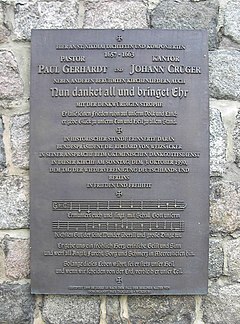
"Nun danket all und bringet Ehr" is a German Lutheran hymn, with a text written by Paul Gerhardt and first published in 1647, in Johann Crüger's Praxis pietatis melica. In the 1653 edition, Crüger added a melody that he composed.














